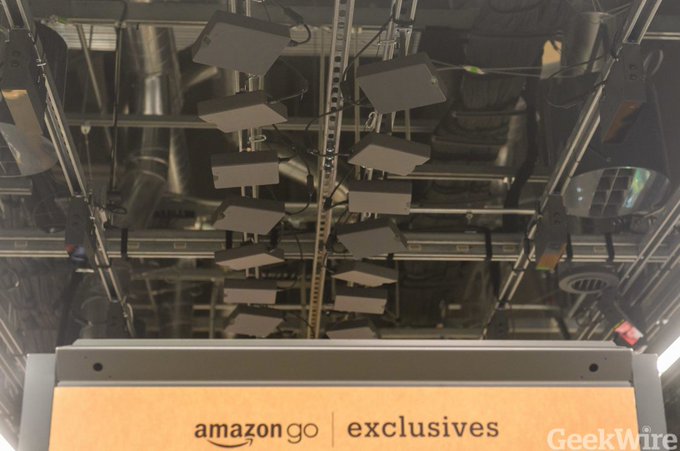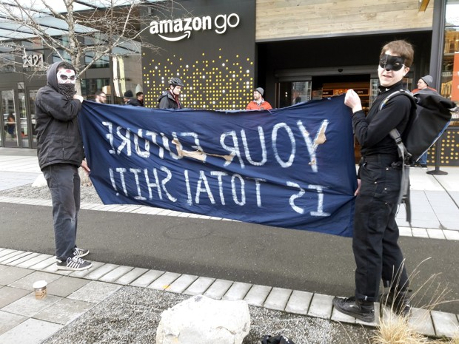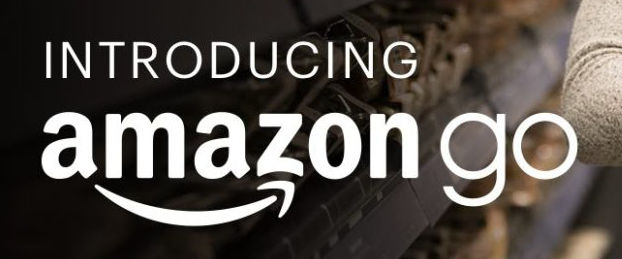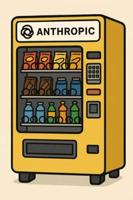Where would a computer vision blog be without a post about the new cashier-less store recently opened to the public by Amazon? Absolutely nowhere.
But I don’t need additional motivation to write about Amazon Go (as the store is called) because I am, to put it simply, thrilled and excited about this new venture. This is innovation at its finest where computer vision is playing a central role.
How can you not get enthusiastic about it, then? I always love it when computer vision makes the news and this is no exception.
In this post, I wish to talk about Amazon Go under four headings:
- How it all works from a technical (as much as is possible) and non-technical perspective,
- Some of the reported issues prior to public opening,
- Some reported in-store issues post public opening, and
- Some potential unfavourable implications cashier-less stores may have in the future (just to dampen the mood a little)
So, without further ado…
How it Works – Non-Technically & Technically
The store has a capacity of around 90 people – so it’s fairly small in size, like a convenience store. To enter it you first need to download the official Amazon app and connect it to your Amazon Prime account. You then walk up to a gate like you would at a metro/subway and scan a QR code from the app. The gate opens and your shopping experience begins.
Inside the store, if you wish to purchase something, you simply pick it up off the shelf and put it in your bag or pocket. Once you’re done, you walk out of the shop and a few minutes later you get emailed a receipt listing all your purchases. No cashiers. No digging around for money or cards. Easy as pie!
What happens on the technical side of things behind the scenes? Unfortunately, Amazon hasn’t disclosed much at all, which is a bit of a shame for nerds like me. But I shouldn’t complain too much, I guess.
What we do know is that sensor fusion is employed (sensor fusion is when data is combined from multiple sensors/sources to provide a higher degree of accuracy) along with deep learning.
Hundreds of cameras and depth sensors are attached to the ceiling around the store:

These track you and your movements (using computer vision!) throughout your expedition. Weight sensors can also be found on the shelves to assist the cameras in discerning which products you have chosen to put into your shopping basket.
(Note: sensor fusion is also being employed in autonomous cars. Hopefully I’ll be writing about this as well soon.)
In 2015, Amazon filed a patent application for its cashier-less store in which it stated the use of RGB cameras (i.e. colour cameras) along with facial recognition. TechCrunch, however, has reported that the Vice President of Technology at Amazon Go told them that no facial recognition algorithms are currently being used.
In-Store Issues Prior to Public Opening
Although the store opened its doors to the public a few weeks ago, it has been open to employees since December 2016. Initially, Amazon expected the store to be ready for public use a few months after that but public opening was delayed by nearly a year due to “technical problems“.
We know what some of the dilemmas behind these “technical problems” were.
Firstly, Amazon had problems tracking more than 20 people in the store. If you’ve ever worked on person-tracking software, you’ll know how hard it is to track a crowd of people with similar body types and wearing similar clothes. But it looks like this has been resolved (to at least a satisfactory level for them). It’s a shame for us, though, to not be given more information on how Amazon managed to get this to work.
Funnily enough, some employees of Amazon knew about this problem and in November last year tried to see if a solution had been developed. Three employees dressed up in Pikachu costumes (as reported by Bloomberg here) while doing their round of shopping to attempt to fool the system. Amazon Go passed this thorough, systematic, and very scientific test. Too bad I couldn’t find any images or videos of this escapade!
We also know that initially engineers were assisting the computer vision system behind the scenes. The system would let these people know when it was losing confidence with its tracking results and would ask them to intervene, at least minimally. Nobody is supposedly doing this task any more.
Lastly, I also found information stating that the system would run into trouble when products were taken off the shelf and placed back on a different shelf. This was reported to have occurred when employees brought their children into the store and they ran wild a little (as children do).
This also appears to have been taken care of because someone from the public attempted to do this on purpose last week (see this video) but to no adverse effects, it would seem.
It’s interesting to see the growing pains that Amazon Go had to go through, isn’t it? How they needed an extra year to try to iron out all these creases. This is such a huge innovation. Makes you wonder what “creases” autonomous cars will have when they become more prominent!
In-Store Issues Post Public Opening
But, alas. It appears as though not all creases were ironed out to perfection. Since Amazon Go’s opening a few weeks ago, two issues have been written about.
The first is of Deirdre Bosa of CNBC not being charged for a small tub of yoghurt:
I think I just shoplifted?? #AmazonGo didn’t charge me for my Siggi’s yogurt 😬 #nolinesnocheckout #freestuff pic.twitter.com/RDPhC5ryXD
— Deirdre Bosa (@dee_bosa) January 22, 2018
The Vice President of Amazon Go responded in the following way:
First and foremost, enjoy the yogurt on us. It happens so rarely that we didn’t even bother building in a feature for customers to tell us it happened. So thanks for being honest and telling us. I’ve been doing this a year and I have yet to get an error.
The yoghurt manufacturer replied to that tweet also:
oh no! It’s ok, that one’s on us 😉
— siggi’s (@siggisdairy) January 22, 2018
To which Dierdre responded: “Thanks Siggi’s! But I think it’s on Amazon :)”
LOL! 🙂
But as Amazon Go stated, it’s a rarity for these mistakes to happen. Or is that only the case until someone works out a flaw in the system?
Well, it seems as though someone has!
In this video, Tim Pool states that he managed to walk out of the Amazon Go store with a bag full of products and was only charged for one item. According to him it is “absurdly easy to take a bag full of things and not get charged”. That’s a little disconcerting. It’s one thing when the system makes a mistake every now and then. It’s another thing when someone has worked out how to break it entirely.
Tim Pool says he has contacted Amazon Go to let them know of the major flaw. Amazon confirmed with him that he did not commit a crime but “if used in practice what we did would in fact be shoplifting”.
Ouch. I bet engineers are working on this frantically as we speak.
One more issue worth mentioning that isn’t really a flaw but could also be abused is that at the moment you can request a refund on any item without returns. No questions asked. Linus Tech Tips shows in this video how easily this can be done. Of course, since your Amazon Go account needs to be linked to your Amazon Prime account, if you do this too many times, Amazon will catch on and will probably take some form of preventative action against you or will even verify everything by looking back at past footage of you.
Cons of Amazon Go
Like I said earlier, I am really excited about Amazon Go. I always love it when computer vision spearheads innovation. But I also think it’s important to in this post also talk about potential unfavourable implications of a cashier-less store.
Potential Job Losses
The first most obvious potential con of Amazon Go is the job losses that might ensue if this innovation catches on. Considering that 3.5 million people in the US are employed as cashiers (it’s the second-most common job in that country), this issue needs to be raised and discussed. Heck, there have already been protests in this respect outside of Amazon Go:

Bill Ingram, the organiser of the protest shown above asks: “What will all the cashiers do once their jobs are automated?”
Amazon, not surprisingly, has issued statements on this topic. It has said that although some jobs may be taken by automation, people can be relocated to improve other areas of the store by, for example:
Working in the kitchen and the store, prepping ingredients, making breakfast, lunch and dinner items, greeting customers at the door, stocking shelves and helping customers
Let’s also not forget that new jobs have also been created. For example, additional people need to be hired to manage the technological infrastructure behind this huge endeavour.
Personally, I’m not a pessimist about automation either. The industrial revolution that brought automation to so many walks of life was hard at first but society found ways to re-educate into other areas. The same will happen, I believe, if cashier-less stores become a prominent thing (and autonomous cars also, for that matter).
An Increase in Unhealthy Impulse Purchases
Manoj Thomas, a professor of marketing at Cornell University, has stated that our shopping behaviour will change around cashier-less stores:
[W]e know that when people use any abstract form of payment, they spend more. And the type of products they choose changes too.
What he’s saying is that psychological research has shown that the more distance we put between us and the “pain of paying” the more discipline we need to avoid those pesky impulse purchases. Having cash physically in your hand means you can what you’re doing with your money more easily. And that extra bit of time waiting in line at the cashier could be time enough to reconsider purchasing that chocolate and vanilla tub of ice cream :/
Even More Surveillance
And then we have the perennial question of surveillance. When is too much, too much? How much more data about us can be collected?
With such sophisticated surveillance in-store, companies are going to have access to even more behavioural data about us: which products I looked at for a long time; which products I picked up but put back on the shelf; my usual path around a store; which advertisements made me smile – the list goes on. Targeted advertising will become even more effective.
Indeed, Bill Ingram’s protest pictured above was also about this (hence why masks were worn to it). According to him, we’re heading in the wrong direction:
If people like that future, I guess they can jump into it. But to me, it seems pretty bleak.
Harsh, but there might be something to it.
Less Human Interaction
Albert Borgmann, a great philosopher on technology, coined the term device paradigm in his book “Technology and the Character of Contemporary Life” (1984). In a nutshell, the term is used to explain the hidden, detrimental nature and power of technology in our world (for a more in-depth explanation of the device paradigm, I highly recommend you read his philosophical works).
One of the things he laments is how we are increasingly losing daily human interactions due to the proliferation of technology. The sense of a community with the people around us is diminishing. Cashier-less stores are pushing this agenda further, it would seem. And considering, according to Aristotle anyway, that we are social creatures, the more we move away from human interaction, the more we act against our nature.
The Chicago Tribune wrote a little about this at the bottom of this article.
Is this something worth considering? Yes, definitely. But only in the bigger picture of things, I would say. At the moment, I don’t think accusing Amazon Go of trying to damage our human nature is the way to go.
Personally, I think this initiative is something to celebrate – albeit, perhaps, with just the faintest touch of reservation.
Summary
In this post I discussed the cashier-less store “Amazon Go” recently opened to the public. I looked at how the store works from a technical and non-technical point of view. Unfortunately, I couldn’t say much from a technical angle because of the little amount of information that has been disclosed to us by Amazon. I also discussed some of the issues that the store has dealt with and is dealing with now. I mentioned, for example, that initially there were problems in trying to track more than 20 people in the store. But this appears to have been solved to a satisfactory level (for Amazon, at least). Finally, I dampened the mood a little by holding a discussion on the potential unfavourable implications that a proliferation of cashier-less stores may have on our societies. Some of the issues raised here are important but ultimately, in my humble opinion, this endeavour is something to celebrate – especially since computer vision is playing such a prominent role in it.
To be informed when new content like this is posted, subscribe to the mailing list (or subscribe to my YouTube channel!):




2 Replies to “Amazon Go – Computer Vision at the Forefront of Innovation”